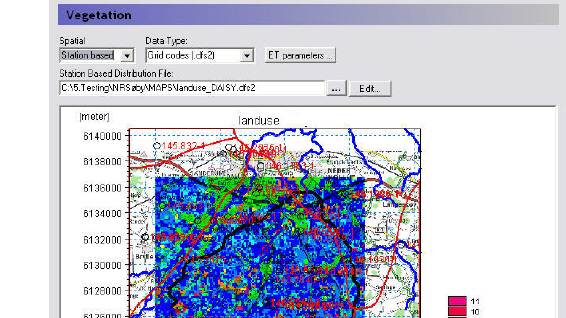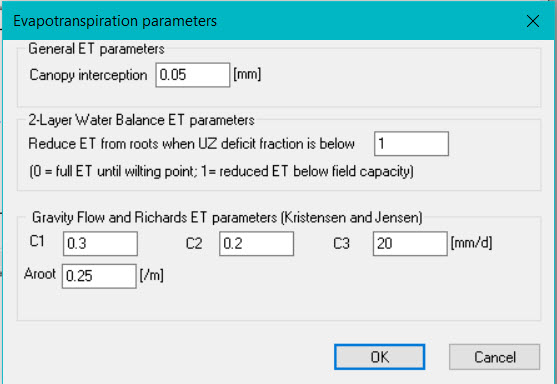
|
Vegetation |
|
|---|---|
|
Conditions: |
If Evapotranspiration selected in the Simulation Specification dialogue |
|
Grid Code |
|
|
Time Series EUM Data Units |
Leaf Area Index and Root Depth, or Vegetation Property File (see Vegetation Properties Editor (V1 p. 403)) |
|
dialogue Type: |
Special version of Time-varying Real Data |

The main Vegetation dialogue is used to define the distribution of vegetation across your model area. It works the same as any other dialogue for Grid Codes with associated time series data. In this case, however, there are two relevant time series parameters: the Leaf Area Index and the Root Depth. Both of these parameters can be defined as constants, via .dfs0 files, or they can be defined from a Vegetation Properties file.
Note. The crop coefficient, Kc, is only available in the Vegetation Properties file.

The Vegetation dialogue also includes a button labelled ET Parameters... Clicking on this button pops up the dialogue for specifying the default ET parameters. The Evapotranspiration parameters in this dialogue do not vary in time and are global for the model. However, if the Vegetation Properties file option is used for the Leaf Area Index and Root Depth parameters, these values can be overridden by crop specific values specified in the vegetation properties file.
The following sections are condensed from the Evapotranspiration - Technical Reference (V1 p. 425) chapter, which should be consulted for more detailed information.
Canopy Interception
The interception process is modelled as an interception storage, which must be filled before stem flow to the ground surface takes place. The coefficient Cint defines the interception storage capacity of the vegetation per unit of LAI. A typical value is about 0.05 mm but a more exact value may be determined through calibration.
Note The interception storage is calculated each time step and the rate of evaporation is usually high enough to remove all the interception storage in each time step. Thus, the total amount of water removed from interception storage depends on the length of the time step. This can lead to confusion when comparing water balances, if the time steps are different. For example, assuming it rains a little in each time step and all the interception storage is removed by ET in every time step, if the time step is halfed, then the total volume of interception storage removed will double.
Deficit Fraction for reduced ET
In nature, plant roots will remove water from the soil until the water content of the soil reaches a critical level. Once this level is reached, transpiration will decrease with decreasing water content until the wilting point is reached, where the amount of transpiration drops to zero.
In the 2-layer model, the maximum deficit is (qmax - qmin), which if the water table is below the extinction depth is field capacity minus the wilting point water contents.
The deficit fraction is the fraction of this maximum deficit before ET begins to be reduced. Thus, transpiration will occur at the maximum rate until this deficit fraction is reached. Then the transpiration will decrease linearly until qmin is reached, at which point transpiration becomes zero.
A typical value for this deficit fraction is about 0.5, which implies that the ET from UZ will be start to be reduced when the deficit is half the maximum allowed. A deficit fraction of 0 implies that no ET will be reduced linearily starting at qmax. A deficit fraction of 1 implies that no ET reduction will be applied and ET will be removed at the maximum rate until the wilting point is reached.
For more information on this variable, see the Section The 2-Layer Water Balance Method (V1 p. 435) in the Technical documentation.
The Kristensen and Jensen equations for actual transpiration and soil evaporation contain three empirical coefficients, C1, C2, and C3. The coefficients C1 and C2 are used in the transpiration function, f1(LAI). C3 is the only variable found in the soil moisture function.
C1 - C1 is plant dependent. For agricultural crops and grass, C1 has been estimated to be about 0.3. C1 influences the ratio soil evaporation to transpiration. This is illustrated in Figure 20.7. For smaller C1 values the soil evaporation becomes larger relative to transpiration. For higher C1 values, the ratio approaches the basic ratio determined by C2 and the input value of LAI.
C2 - For agricultural crops and grass, grown on clayey-loamy soils, C2 has been estimated to be about 0.2. Similar to C1, C2 influences the distribution between soil evaporation and transpiration, as shown in Figure 20.8. For higher values of C2, a larger percentage of the actual ET will be soil evaporation. Since soil evaporation only occurs from the upper most node (closest to the ground surface) in the UZ soil profile, water extraction from the top node is weighted higher. This is illustrated in Figure 20.8, where 23 per cent and 61 per cent of the total extraction takes place in the top node for C2 values of 0 and 0.5 respectively.
Thus, changing C2 will influence the ratio of soil evaporation to transpiration, which in turn will influence the total actual evapotranspiration possible under dry conditions. Higher values of C2 will lead to smaller values of total actual evapotranspiration because more water will be extracted from the top node, which subsequently dries out faster. Therefore, the total actual evapotranspiration will become sensitive to the ability of the soil to draw water upwards via capillary action.
C3 - C3 has not been evaluated experimentally. Typically, a value for C3 of 20 mm/day is used, which is somewhat higher than the value of 10 mm/day proposed by Kristensen and Jensen (1975). C3 may depend on soil type and root density. The more water released at low matrix potential and the greater the root density, the higher should the value of C3 be. Further discussion is given in Kristensen and Jensen (1975).
Root Mass Distribution Parameter, AROOT
In the Kristensen and Jensen model, water extraction by the roots for transpiration varies over the growing season. In nature, the exact root development is a complex process, which depends on the climatic conditions and the moisture conditions in the soil. Thus, MIKE SHE allows for a root distribution determined by the root depth (time varying) and a general, vertical root-density distribution, defined by AROOT, see Figure 20.3. In the above dialogue, AROOT is not time varying, but can be specified as a time series using the Vegetation Properties Editor (V1 p. 403).
How the water extraction is distributed with depth depends on the AROOT parameter. Figure 20.4 shows the distribution of transpiration for different values of AROOT, assuming that the transpiration is at the reference rate with no interception loss (Cint=0) and no soil evaporation loss (C2=0). The figure shows that the root distribution, and the subsequent transpiration, becomes more uniformly distributed as AROOT approaches 0. During simulations, the total actual transpiration tends to become smaller for higher values of AROOT because most of the water is drawn from the upper layer, which subsequently dries out faster. The actual transpiration, therefore, becomes more dependent on the ability of the soil to conduct water upwards (capillary rise) to the layers with high root density.
Figure 20.5 shows the effect of the root depth, given the same value of AROOT. A shallower root depth will lead to more transpiration from the upper unsaturated zone layers because a larger proportion of the roots will be located in the upper part of the profile. However, again, this may lead to smaller actual transpiration, if the ability of the soil to conduct water upwards is limited.
The root distribution is also important for distributing the ET extraction between the SZ and UZ models. If the water table is above the bottom of the roots then ET will be extracted from SZ. The relative amount of ET removed from SZ will depend on the fraction of roots below the water table.
Thus, AROOT is an important parameter for estimating how much water can be drawn from the soil profile under dry conditions.
Related Items
· Kristensen and Jensen method (V1 p. 427)
· The 2-Layer Water Balance Method (V1 p. 435)
· Vegetation Properties (V1 p. 250)
· Vegetation Properties Editor (V1 p. 403)